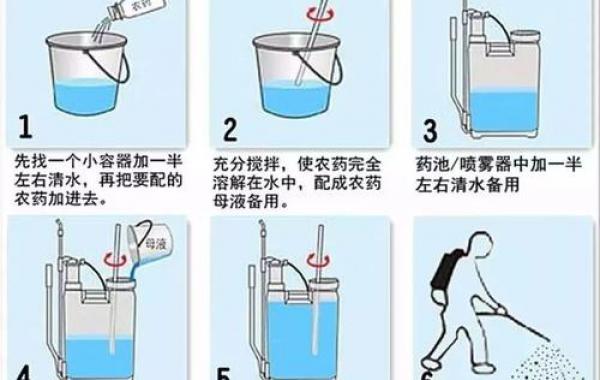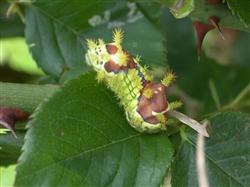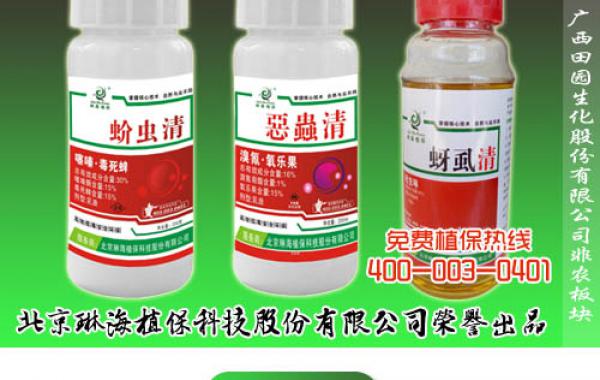leafhopper Learn more about leafhopper
-
Experiment on the efficacy of 10% chlorothioline wettable powder in the treatment of tea leafhopper

Efficacy test of 10% chlorothioline wettable powder against tea green leafhopper Abstract: field experiments showed that 10% chlorothioline wettable powder had good control effect on tea small green leafhopper, and the control effect was still more than 80% after 14 days. Key words: chlorothioline; tea small green leafhopper; control effect 10% chlorothioline wettable powder is a nitromethylene internal absorption insecticide. The mechanism of action of chlorothioline is selective inhibition of nicotinic acid acetylcholinesterase receptor in insect nervous system.
2019-01-15 -
Control methods of small green leafhopper in organic tea garden

Control methods of small green leafhopper in organic tea garden
2018-07-25 -
Control of small green leafhopper with false eyes in tea plant

False-eyed small green leafhopper, commonly known as floating dust, is one of the main pests on tea trees in various tea areas of our province. Due to its harm, the light bud leaves are damaged, the yield is reduced, and the heavy bud leaves are destroyed, resulting in loss of harvest. 1. Morphological characteristics of the false-eyed small green leafhopper belongs to Homoptera, Cicadellidae. The whole life goes through three stages of egg → nymph → adult. 1. The egg is crescent-shaped, about 0.8 mm long and 0.15 mm wide, initially milky white, gradually turning light green, and a pair of red eye spots can be seen through the front end before hatching. 2. Nymphs total 5
2019-01-16 -
Identification and control of tea small green leafhopper

Small green leafhopper, also known as floating dust, is the most important pest of tea trees. It is harmful to nymphs and adults to suck the sap of tender shoots and leaves of tea trees, causing the leaves to yellowing and losing green, the veins turning red, the leaves thick and old, and when serious, the tip and edge of the leaves are red-brown and scorched, the leaves of the buds are shrunk, the growth is stagnant, and even all of them are scorched like fire. When the injured leaves are made into dry tea, the broken powder increases, the taste is bitter and astringent, and the yield and quality are seriously affected. The adult of small green leafhopper is 3.5 mm long, light green to yellowish green, with two small green spots in the middle of the head and a small scutellum in the middle of the head.
2019-01-15 -
Control of tea false-eyed small green leafhopper

Tea false-eyed small green leafhopper alias false-eyed small green floating dust, small green leafhopper and so on, is one of the most important insect pests of tea in Fujian Province. The adult and nymph were mainly used to suck the juice of the tender shoot of the tea tree, and the female adult laid eggs in the stem of the tender shoot, which hindered the growth of the tea tree, curled and hardened the leaves of the damaged buds, and scorched the leaf tip and leaf edge, which affected the yield and quality of tea. The insect occurs for many generations a year in Fujian Province, and the generations overlap. It occurs 12-13 generations a year in low mountain tea areas, and the damage peak period is from May to June and September to October.
2019-01-15 -
How to mix pesticides to prevent flower diseases?

How to mix pesticides to prevent flower diseases?
2020-11-05 -
Control method of jujube blight in spring with dense twigs which are long and difficult to shed

Control method of jujube blight in spring with dense twigs which are long and difficult to shed
2018-07-11 -
Rice dwarf disease

The symptoms were mainly distributed in the southern rice area. Also known as rice common dwarf disease, general dwarf, green dwarf and so on. After the rice was susceptible from seedling stage to tillering stage, the plant was dwarfed, the tillers increased, the leaves were thick green and stiff, and the diseased rice could not heading and fruiting in the later growth stage. The symptoms of diseased leaves can be divided into two types. The white spot type appeared dotted yellow-white spots parallel to the leaf vein on the leaf blade or on the leaf sheath, especially at the base. Dots appeared in the new leaves above the initial diseased leaves, but not in the following old leaves. In the twisted type, the extraction of the heart lobe is distorted in the case of lack of light.
2019-01-16 -
Insecticides commonly used in flowers and potted plants

Insecticides commonly used in flowers and potted plants
2019-07-18 -
How to control rice electric leafhopper

The scientific name Inazumadorsalis (Motschulsky) synonym and Reciliadorsalis (Motschulsky) belongs to Homoptera, Cicadellidae. It is distributed in the rice areas south of the Yellow River. Host rice, corn, sorghum, millet, sugarcane, wheat, barley and so on. Accidentally harm sesame seeds, oranges, etc. The characteristics of the damage were that adults and nymphs pricked and sucked juice on rice leaves and leaf sheaths, resulting in inhibition of the growth and development of injured plants, yellowing of leaves or wilting of the whole plant.
2019-01-16 -
Control of the disease of mango leaf hopper

Mango flat beak leafhopper, also known as leaf hopper, damages flowers and young fruits, resulting in flower and fruit drop, poor harvest or even loss of harvest, and induces serious soot disease, but also damages young buds, tender shoots and leaves, resulting in bud and leaf deformity. Usually occurs more during flowering, humidity is high, trees
2020-11-08 species mango flat beak leafhopper diseased control -
What is the Chinese rose leafhopper?

How to control Spodoptera litura? Please guide the rose yellow moth: morphological features: adults orange-yellow, antennae filamentous brown diagonal, converging at the tip of the wing. It is inverted v-shaped, the hind wings are grayish yellow, the feet are brown, the eggs are flat and oval, yellowish. The larva is slightly rectangular, the front end is slightly larger, and the body color.
2018-07-18 -
Pest control of licorice

(1) leafhopper: there are mainly elm leafhopper, small green leafhopper and so on. It occurs in the whole growing period of licorice, and the damage is the most serious from late June to mid-August. When nymphs or adults suck the leaves, buds, young branches and buds of licorice, they first show silver spots, then the leaves lose green and show light yellow, and finally fall off. Control method: remove the elm and other leafhopper overwintering hosts around the licorice field. The peak of the damage was prevented by spraying 2.5% deltamethrin 1000Mel 1500 times. Use grass aphids, ladybugs, etc.
2019-01-16 -
Technical plan for prevention and control of main tea diseases and insect pests in 2019

The main diseases and insect pests in tea gardens in China are tea small green leafhopper (small green leafhopper), black whitefly, gray tea inchworm, tea inchworm, tea caterpillar, tea orange gall mite, coffee claw mite, horned breast beetle, tea net bug, tea black poison moth, tea yellow thrips, tea stick thrips and tea stick thrips.
2020-11-09 In 2019 tea trees major diseases and insect pests prevention and control technology programs national -
Tea planting techniques: how to control pests in summer tea garden?

How to control pests in summer tea garden? Please introduce the control methods. The main pests in tea garden in July are false-eyed green leafhopper, whitefly, wax cicada and tea inchworm, which should be controlled as soon as possible. Wax cicada, whitefly whitefly and false-eye small green leafhopper are all prick-sucking pests.
2018-07-17 -
What are the flower pesticides, how to make flower pesticides

What are the flower pesticides, how to make flower pesticides
2020-11-03 -
What medicine to prevent what harm, what vegetable to give what medicine! Take a quick look.

What medicine to prevent what harm, what vegetable to give what medicine! Take a quick look.
2019-02-20 -
Rapid preparation of Flower Pesticide

Rapid preparation of Flower Pesticide
2021-01-21 -
The method of making Green harmless Flower Pesticide

The method of making Green harmless Flower Pesticide
2020-04-30 -
Earthwork to make flowers and pesticides is actually very simple.

Earthwork to make flowers and pesticides is actually very simple.
2021-01-30
